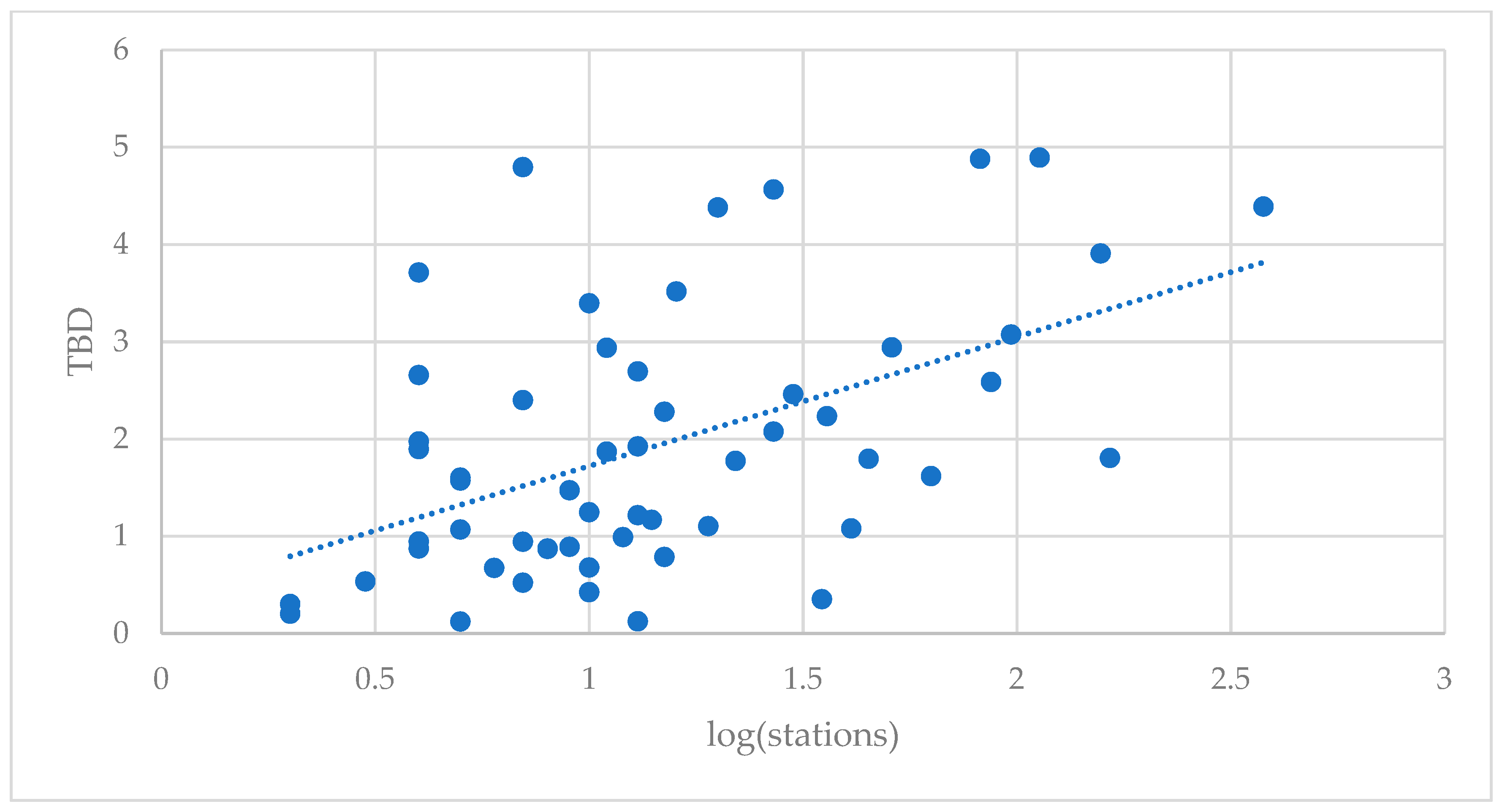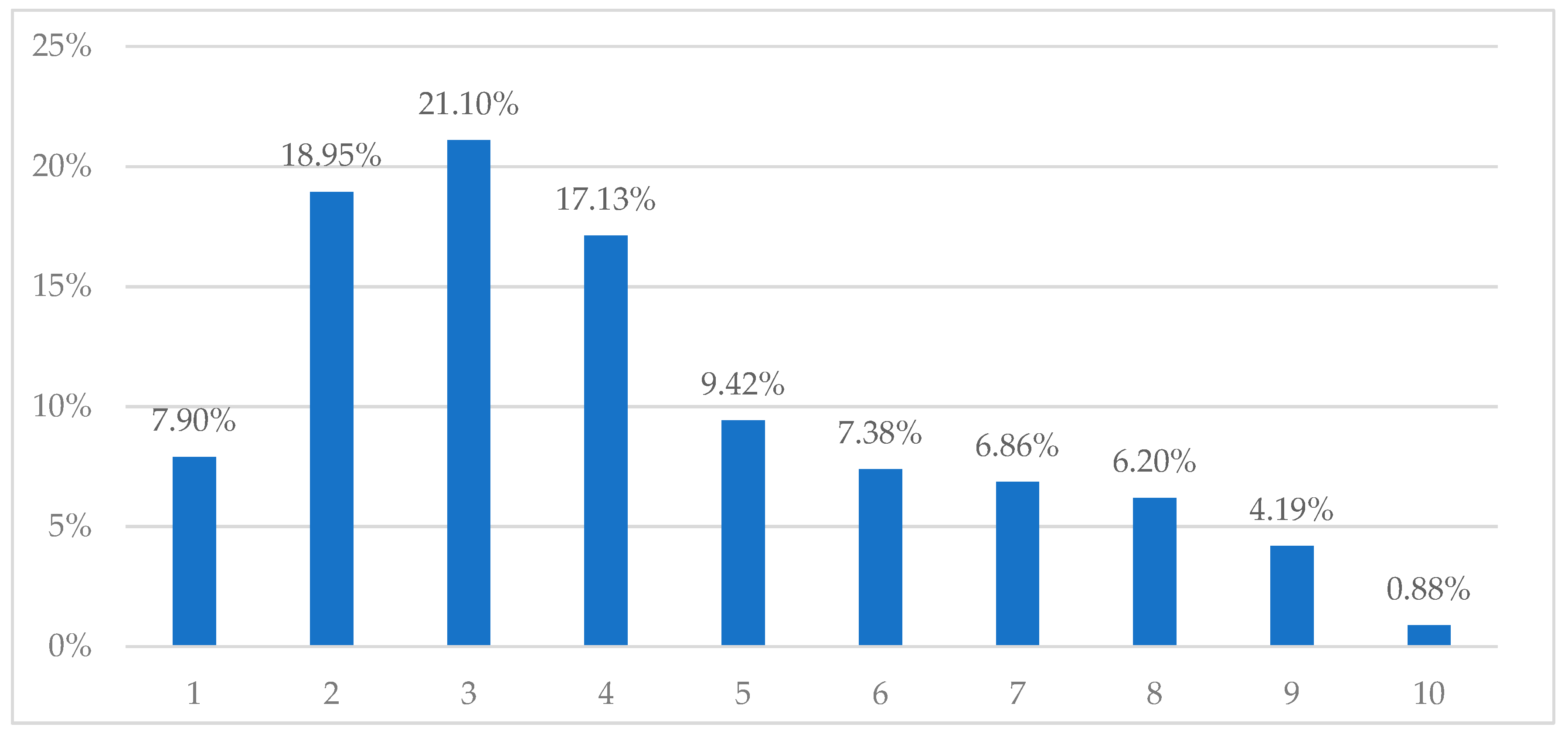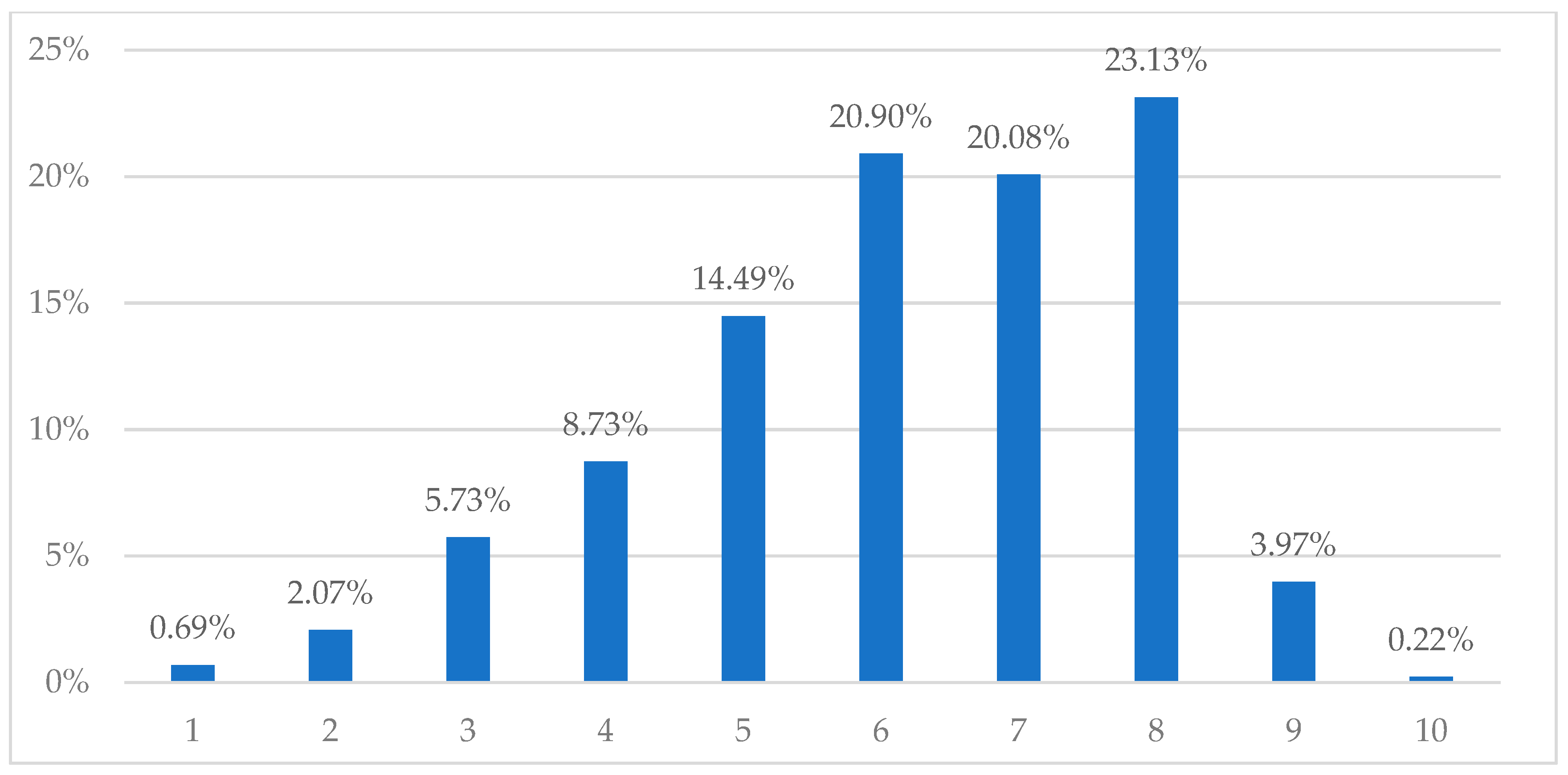Bike-Sharing Systems in Poland
Abstract
1. Introduction
2. Materials and Methods
2.1. Data Used for Regression Model
2.2. Survey Data
2.3. Method
+ β5 #CarsPerPersoni + β6 PathsKmPer10KPopi + β7 PaytoAvgi + β8Tempi + β8Raini +
+ β9 TuristsPer1000Popi + εi
2.4. Dependent Variable
2.5. Independent Variables
2.5.1. Urban Features
2.5.2. BSS Characteristics
2.5.3. Weather
3. Results
3.1. General Information and Basic Data on Bike-Sharing Systems in Poland
3.2. Regression Analysis of the Factors Influencing BSS Performance
4. Discussion
4.1. General Discussion
4.2. Implications
4.3. Limitations and Future Research
Author Contributions
Funding
Conflicts of Interest
References
- Shaheen, S.A.; Cohen, A.P.; Martin, E.W. Public Bikesharing in North America: Early Operator Understanding and Emerging Trends. Transp. Res. Rec. 2013, 2387, 83–92. [Google Scholar] [CrossRef]
- Demaio, P.; Gifford, J. Will Smart Bikes Succeed as Public Transportation in the United States? J. Public Transp. 2004, 7, 1–15. [Google Scholar] [CrossRef]
- Du, M.; Cheng, L. Better understanding the characteristics and influential factors of different travel patterns in free-floating bike sharing: Evidence from Nanjing, China. Sustainability 2018, 10, 1244. [Google Scholar] [CrossRef]
- Pal, A.; Zhang, Y. Free-floating bike sharing: Solving real-life large-scale static rebalancing problems. Transp. Res. Part C Emerg. Technol. 2017, 80, 92–116. [Google Scholar] [CrossRef]
- Bullock, C.; Brereton, F.; Bailey, S. The economic contribution of public bike-share to the sustainability and efficient functioning of cities. Sustain. Cities Soc. 2017, 28, 76–87. [Google Scholar] [CrossRef]
- Médard de Chardon, C.; Caruso, G.; Thomas, I. Bicycle sharing system ‘success’ determinants. Transp. Res. Part A Policy Pract. 2017, 100, 202–214. [Google Scholar] [CrossRef]
- Fishman, E.; Washington, S.; Haworth, N.; Watson, A. Factors influencing bike share membership: An analysis of Melbourne and Brisbane. Transp. Res. Part A Policy Pract. 2014, 71, 17–30. [Google Scholar] [CrossRef]
- Fishman, E.; Washington, S.; Haworth, N. Bike Share: A Synthesis of the Literature. Transp. Rev. 2013, 33, 148–165. [Google Scholar] [CrossRef]
- Ricci, M. Bike sharing: A review of evidence on impacts and processes of implementation and operation. Res. Transp. Bus. Manag. 2015, 15, 28–38. [Google Scholar] [CrossRef]
- Zhao, J.; Deng, W.; Song, Y. Ridership and effectiveness of bikesharing: The effects of urban features and system characteristics on daily use and turnover rate of public bikes in China. Transp. Policy 2014, 35, 253–264. [Google Scholar] [CrossRef]
- Fishman, E.; Washington, S.; Haworth, N. Bike share’s impact on car use: Evidence from the United States, Great Britain, and Australia. Transp. Res. Part D Transp. Environ. 2014, 31, 13–20. [Google Scholar] [CrossRef]
- Si, H.; Shi, J.G.; Wu, G.; Chen, J.; Zhao, X. Mapping the bike sharing research published from 2010 to 2018: A scientometric review. J. Clean. Prod. 2019, 213, 415–427. [Google Scholar] [CrossRef]
- Eurostat Database, European Commission. Available online: https://ec.europa.eu/eurostat/data/database (accessed on 12 February 2019).
- Bartosiewicz, B.; Pielesiak, I. Spatial patterns of travel behaviour in Poland. Travel Behav. Soc. 2019, 15, 113–122. [Google Scholar] [CrossRef]
- DeMaio, P. Bike-sharing: History, Impacts, Models of Provision, and Future. J. Public Transp. 2009, 12, 41–56. [Google Scholar] [CrossRef]
- Fishman, E. Bikeshare: A Review of Recent Literature. Transp. Rev. 2016, 36, 92–113. [Google Scholar] [CrossRef]
- Tran, T.D.; Ovtracht, N. Promoting Sustainable Mobility by Modelling Bike Sharing Usage in Lyon; IOP Conference Series: Earth and Environmental Science; IOP Publishing: Bristol, England, 2018. [Google Scholar]
- Li, X.; Zhang, Y.; Sun, L.; Liu, Q. Free-floating bike sharing in jiangsu: Users’ behaviors and influencing factors. Energies 2018, 11, 1664. [Google Scholar] [CrossRef]
- Bieliński, T.; Ważna, A. New Generation of Bike-Sharing Systems in China: Lessons for European Cities. J. Manag. Financ. Sci. 2018, 11, 25–42. [Google Scholar]
- Jiménez, P.; Nogal, M.; Caulfield, B.; Pilla, F. Perceptually important points of mobility patterns to characterise bike sharing systems: The Dublin case. J. Transp. Geogr. 2016, 54, 228–239. [Google Scholar] [CrossRef]
- Kou, Z.; Cai, H. Understanding bike sharing travel patterns: An analysis of trip data from eight cities. Phys. A Stat. Mech. Its Appl. 2019, 515, 785–797. [Google Scholar] [CrossRef]
- Rixey, R.A. Station-Level Forecasting of Bike Sharing Ridership: Station Network Effects in Three U.S. Systems. Transp. Res. Rec. J. Transp. Res. Board 2013, 2387, 46–55. [Google Scholar] [CrossRef]
- Noland, R.B.; Smart, M.J.; Guo, Z. Bikeshare trip generation in New York City. Transp. Res. Part A Policy Pract. 2016, 94, 164–181. [Google Scholar] [CrossRef]
- El-Assi, W.; Salah Mahmoud, M.; Nurul Habib, K. Effects of built environment and weather on bike sharing demand: A station level analysis of commercial bike sharing in Toronto. Transportation 2017, 44, 589–613. [Google Scholar] [CrossRef]
- Shen, Y.; Zhang, X.; Zhao, J. Understanding the usage of dockless bike sharing in Singapore. Int. J. Sustain. Transp. 2018, 12, 686–700. [Google Scholar] [CrossRef]
- Wang, K.; Akar, G.; Chen, Y.J. Bike sharing differences among Millennials, Gen Xers, and Baby Boomers: Lessons learnt from New York City’s bike share. Transp. Res. Part A Policy Pract. 2018, 12, 686–700. [Google Scholar] [CrossRef]
- Guo, Y.; Zhou, J.; Wu, Y.; Li, Z. Identifying the factors affecting bike-sharing usage and degree of satisfaction in Ningbo, China. PLoS ONE 2017, 12, e0185100. [Google Scholar] [CrossRef]
- Sun, F.; Chen, P.; Jiao, J. Promoting public bike-sharing: A lesson from the unsuccessful Pronto system. Transp. Res. Part D Transp. Environ. 2018, 63, 533–547. [Google Scholar] [CrossRef]
- Turoń, K.; Sierpiński, G. Bike-sharing as a possibility to support Vision Zero. MATEC Web Conf. 2018, 231, 03005. [Google Scholar] [CrossRef][Green Version]
- Czech, P.; Turoń, K.; Urbańczyk, R. Bike-sharing as an element of integrated Urban transport system. In Advances in Intelligent Systems and Computing; Springer: Cham, Switzerland, 2018. [Google Scholar]
- Dobrzyńska, E.; Dobrzyński, M. Structure and dynamics of a public bike-sharing system. Case study of the public transport system in Białystok. Eng. Manag. Prod. Serv. 2016, 8, 59–66. [Google Scholar] [CrossRef][Green Version]
- Faghih-Imani, A.; Hampshire, R.; Marla, L.; Eluru, N. An empirical analysis of bike sharing usage and rebalancing: Evidence from Barcelona and Seville. Transp. Res. Part A Policy Pract. 2017, 97, 177–191. [Google Scholar] [CrossRef]
- Gebhart, K.; Noland, R.B. The impact of weather conditions on bikeshare trips in Washington, DC. Transportation 2014, 41, 1205–1225. [Google Scholar] [CrossRef]
- Richter, F. Bike-Sharing Clicks into Higher Gear. Available online: https://www.statista.com/chart/14542/bike-sharing-programs-worldwide/ (accessed on 12 February 2019).
- Sadowska, K. Nextbike Polska Press Release. Available online: https://relacje.nextbike.pl/media/2555/20181115-nextbike-podsumowanie-1-3q2018.docx (accessed on 12 February 2019).
- Akinwande, M.O.; Dikko, H.G.; Samson, A. Variance Inflation Factor: As a Condition for the Inclusion of Suppressor Variable(s) in Regression Analysis. Open J. Stat. 2015, 5, 754–767. [Google Scholar] [CrossRef]
- Kaplan, S.; Manca, F.; Nielsen, T.A.S.; Prato, C.G. Intentions to use bike-sharing for holiday cycling: An application of the Theory of Planned Behavior. Tour. Manag. 2015, 47, 34–46. [Google Scholar] [CrossRef]
- Roman, M.; Roman, M. Bicycle Transport as an Opportunity to Develop Urban Tourism—Warsaw Example. Procedia Soc. Behav. Sci. 2014, 151, 295–301. [Google Scholar] [CrossRef]
- Metz, D. Tackling urban traffic congestion: The experience of London, Stockholm and Singapore. Case Stud. Transp. Policy 2018, 6, 494–498. [Google Scholar] [CrossRef]
- Yin, C.; Shao, C.; Wang, X.; Yin, C.; Shao, C.; Wang, X. Built Environment and Parking Availability: Impacts on Car Ownership and Use. Sustainability 2018, 10, 2285. [Google Scholar] [CrossRef]
- Peters, K.; Elands, B.; Buijs, A. Social interactions in urban parks: Stimulating social cohesion? Urban For. Urban Green. 2010, 9, 93–100. [Google Scholar] [CrossRef]



| Code | Variable Definition | Mean/Proportion | SD | Min | Max |
|---|---|---|---|---|---|
| TDB | Trips per day per bicycle | 1.93 | 1.34 | 0.12 | 4.89 |
| Population | Population of BSS’s primary city or settlement | 177,666 | 276,217 | 2495 | 1,764,615 |
| Nextbike | Operator of the BSS (dichotomous variable) | 0.80 | - | 0 | 1 |
| Years | Number of years since the system was launched | 2.68 | 2.70 | 1 | 11 |
| #StationsPerPop10K | Density of stations: the number of stations per 10,000 of population | 2.01 | 1.49 | 0.34 | 8.02 |
| #CarsPerPerson | Number of cars registered per person in the region | 0.57 | 0.07 | 0.43 | 0.72 |
| PathsKmPer10KPop | Kilometres of bicycle pathways per 10,000 of population | 3.76 | 2.33 | 0.00 | 11.93 |
| Pay to Avg | Ratio of an average salary in the region to the national average | 95.45 | 14.15 | 76.10 | 146.00 |
| Temp | Average temperature during the time the system was functioning | 14.29 | 2.74 | 6.40 | 20.10 |
| Rain | Number of rainy days during the time the system was functioning | 52.18 | 28.30 | 10.00 | 146.00 |
| TouristsPer1000Pop | Number of tourists that used hotel services in a given city or settlement per 1000 population. | 865.08 | 1230.72 | 130.22 | 8517.22 |
| Code | Estimate | SE | p-Value | Significance Code | VIF |
|---|---|---|---|---|---|
| (Intercept) | −15.00 | 2.52 | 0 | *** | |
| Log(Population) | 1.08 | 0.18 | 0 | *** | 3.37 |
| Nextbike | 0.84 | 0.33 | 0.02 | ** | 1.26 |
| Log(Years) | −0.41 | 0.25 | 0.11 | 2.71 | |
| #StationsPerPop10K | 0.30 | 0.12 | 0.02 | ** | 2.19 |
| #CarsPerPerson | 3.39 | 1.98 | 0.09 | * | 1.45 |
| PathsKmPer10KPop | 0.10 | 0.06 | 0.08 | * | 1.26 |
| Pay to Avg | 0 | 0.01 | 0.92 | 2.23 | |
| Temp | 0.11 | 0.05 | 0.04 | ** | 1.20 |
| Rain | −0.01 | 0.01 | 0.09 | * | 1.76 |
| TuristsPer1000Pop | 0 | 0 | 0.09 | * | 1.24 |
| Adjusted R squared | 0.55 |
© 2019 by the authors. Licensee MDPI, Basel, Switzerland. This article is an open access article distributed under the terms and conditions of the Creative Commons Attribution (CC BY) license (http://creativecommons.org/licenses/by/4.0/).
Share and Cite
Bieliński, T.; Kwapisz, A.; Ważna, A. Bike-Sharing Systems in Poland. Sustainability 2019, 11, 2458. https://doi.org/10.3390/su11092458
Bieliński T, Kwapisz A, Ważna A. Bike-Sharing Systems in Poland. Sustainability. 2019; 11(9):2458. https://doi.org/10.3390/su11092458
Chicago/Turabian StyleBieliński, Tomasz, Agnieszka Kwapisz, and Agnieszka Ważna. 2019. "Bike-Sharing Systems in Poland" Sustainability 11, no. 9: 2458. https://doi.org/10.3390/su11092458
APA StyleBieliński, T., Kwapisz, A., & Ważna, A. (2019). Bike-Sharing Systems in Poland. Sustainability, 11(9), 2458. https://doi.org/10.3390/su11092458







